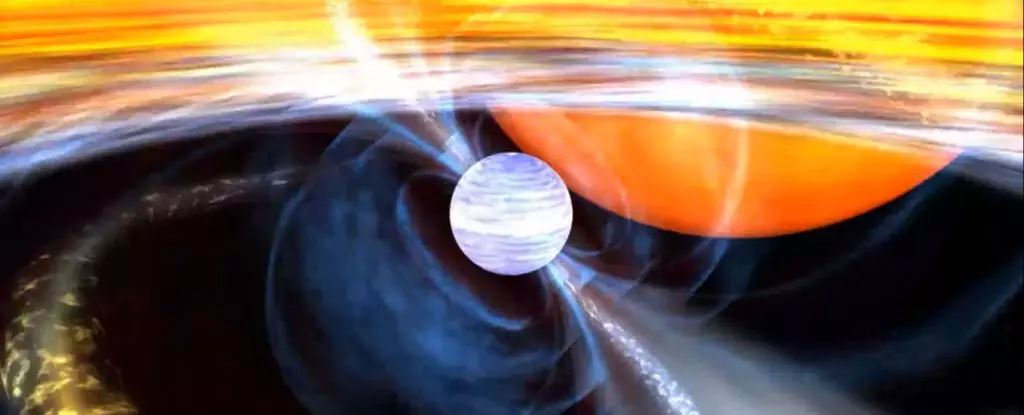In the vast expanse of the universe, a neutron star located a staggering 27,400 light-years away is captivating astronomers with its extraordinary rotational speed, marking one of the most spectacular phenomena observed in the cosmos. Situated in the binary system known as 4U 1820-30, this neutron star spins at a jaw-dropping rate of 716 rotations per second. This stellar dance pushes the boundaries of our understanding of neutron star dynamics and their limits, placing it in contention with the famed pulsar PSR J1748-2446ad, believed to be the only other star spinning at such a remarkable pace.
A research team led by Gaurava Jaisawal from the Technical University of Denmark has shed light on this remarkable discovery, asserting its significance in confirming theoretical models that predict neutron stars could achieve speeds nearing 730 rotations per second. The intriguing question that arises from this research is whether 4U 1820-30 could redefine these upper limits once subsequent observations affirm its findings.
To appreciate the uniqueness of neutron stars, one must understand their origin. Massive stars between eight and thirty solar masses undergo a cataclysmic process at the end of their life cycles. When they’ve exhausted their fuel for nuclear fusion, they face gravitational collapse, leading to the violent expulsion of their outer layers in a supernova explosion. This left-behind core collapses under immense pressure, morphing into a neutron star—a dense entity the size of a mere 20 kilometers across yet possessing up to 2.3 times the mass of our Sun.
The lifecycle of these stars is marked by eccentric behaviors. Neutron stars are categorized based on their characteristics; for instance, magnetars are recognized for their extraordinarily strong magnetic fields, while pulsars emit beams of radiation, appearing like cosmic lighthouses in the vastness of space.
The binary system of 4U 1820-30 has been a subject of intrigue since its discovery in the 1980s. Located in the constellation Sagittarius, this system comprises a neutron star and a white dwarf star in a close, fast orbit with a period of just 11.4 minutes. The closeness of these celestial bodies facilitates a spectacular interaction; the neutron star siphons material from its companion. This accreted mass doesn’t just collect idly; it becomes progressively denser and hotter, eventually triggering spectacular thermonuclear explosions.
Jaisawal’s research team utilized NASA’s Neutron Star Interior Composition Explorer (NICER)—an X-ray telescope mounted on the International Space Station—to study these violent explosions. During these eruptions, the neutron star’s brightness can eclipse that of the Sun by a factor of 100,000 times, catapulting scientists into an exhilarating journey through extreme astrophysical events.
While studying the thermonuclear blasts that occurred between 2017 and 2022, the research team observed peculiar oscillations in one of the explosions, characterized by a 716 Hertz frequency. This unexpected oscillation suggested that the neutron star might be experiencing additional rotational dynamics during these violent events. Through meticulous data analysis, the team posited that 4U 1820-30 could be classified as an X-ray pulsar, spinning at 716 rotations per minute—a groundbreaking assertion that, if validated, would make it the swiftest-known nuclear-powered pulsar.
Astrophysicist Jerome Chenevez emphasized the importance of studying these extreme bursts, as they offer vital insights into binary star evolutions and the cosmic processes responsible for element formation. Each discovery in this realm enhances our understanding of stellar lifecycle dynamics and the factors that facilitate the formation of heavier elements in the universe.
While the results from the 4U 1820-30 observations are fascinating and provoke excitement among astronomers, they also come with the necessary caveat of requiring further observation and confirmation. The stakes are considerable; if the finding stands the test of scrutiny, it will pave the way for new methodologies in studying neutron stars.
Ultimately, breakthroughs in understanding these cosmic phenomena carry profound implications not only for our knowledge of neutron stars but also for the broader tale of the universe’s formation and evolution. In a tapestry of stardust and cosmic events, 4U 1820-30 may be weaving a narrative that our scientific instruments are only beginning to unravel. As the universe continues to unfold its secrets, we stand on the precipice of exciting discoveries that challenge the limits of our understanding of astrophysics and the life cycles of stars.


Leave a Reply